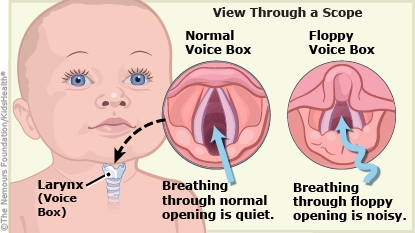Babies with laryngomalacia (or "floppy voice box") have noisy breathing because their airways fall in and get partly blocked. This is usually harmless, but the baby makes a harsh or squeaky sound when breathing in. Laryngomalacia tends to get better as a baby gets older.



Your child:


What is laryngomalacia? Laryngomalacia is a softness in the larynx (voice box) that some babies are born with. When they breathe in, the part of the voice box above the vocal cords falls in, partly blocking the airway. This can cause a high-pitched or harsh sound called stridor. It may happen only some of the time or get louder in certain situations — for example, when the baby is sleeping, crying, or feeding.
How is laryngomalacia diagnosed? Health care providers usually diagnose laryngomalacia by asking the parent about the baby's symptoms and doing an exam. They may recommend a laryngoscopy to confirm the diagnosis. In this procedure, an otolaryngologist (ear, nose, and throat doctor) passes a thin tube with a small camera at the end down the baby's throat to look for laryngomalacia and other problems that can cause stridor.
How is laryngomalacia treated? Most babies grow out of laryngomalacia, so treatment often isn't needed if a baby is feeding and growing well. Treatments for laryngomalacia include: